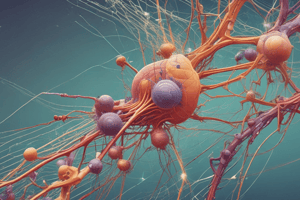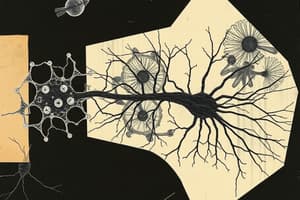Podcast
Questions and Answers
What happens to the A and C free lamin dimers when phosphorylation ceases?
What happens to the A and C free lamin dimers when phosphorylation ceases?
- They break down into desmosomes
- They reform lamina (correct)
- They dissolve into actin filaments
- They transform into microtubules
What type of connection is characterized by the presence of desmosomes and hemidesmosomes?
What type of connection is characterized by the presence of desmosomes and hemidesmosomes?
- Tight junction
- Focal adhesion
- Adherent connection (correct)
- Gap junction
What is the primary function of intermediate filaments in the context of cell adhesion?
What is the primary function of intermediate filaments in the context of cell adhesion?
- To provide mechanical support (correct)
- To facilitate cell migration
- To anchors microtubules
- To regulate cell signaling
Which of the following is NOT a type of cell junction?
Which of the following is NOT a type of cell junction?
What is the term for the process by which A and C free lamin dimers convert into lamina?
What is the term for the process by which A and C free lamin dimers convert into lamina?
What type of filament is characterized by being stiff and hollow?
What type of filament is characterized by being stiff and hollow?
During mitosis, what happens to the nuclear lamina?
During mitosis, what happens to the nuclear lamina?
What is the primary function of focal adhesions?
What is the primary function of focal adhesions?
What is the term for the type of connection characterized by the presence of desmosomes?
What is the term for the type of connection characterized by the presence of desmosomes?
What is the primary component of intermediate filaments?
What is the primary component of intermediate filaments?
Flashcards are hidden until you start studying
Study Notes
Cell Skeleton
- Cells are mechanically connected to their surroundings and other cells, with some exceptions.
- The cell skeleton is a dynamic structure that plays a crucial role in maintaining cell shape, movement, and internal organization.
- It has three main components: microtubules, intermediate filaments, and actin filaments.
Actin Filaments
- Actin filaments are dynamic structures that can form and dissolve with the help of associated proteins.
- Nucleation is the initial step in polymerization, which requires ATP binding.
- Actin filaments can form bundled structures (actin cables) and mesh-like structures (actin networks) in cells.
- Associated proteins like ADF/cofilin and profilin regulate the formation and dissolution of actin filaments.
Intermediate Filaments
- Intermediate filaments are stable structures that provide mechanical support to cells.
- They consist of desmosomes (adhesion molecules) and hemidesmosomes (half-desmosomes).
- Intermediate filaments connect cells to their surroundings and to other cells.
Microtubules
- Microtubules are rigid, hollow tubes that provide structural support to cells.
- They play a crucial role in maintaining cell shape, movement, and internal organization.
- Microtubules are dynamic structures that can form and dissolve with the help of associated proteins.
Studying That Suits You
Use AI to generate personalized quizzes and flashcards to suit your learning preferences.




